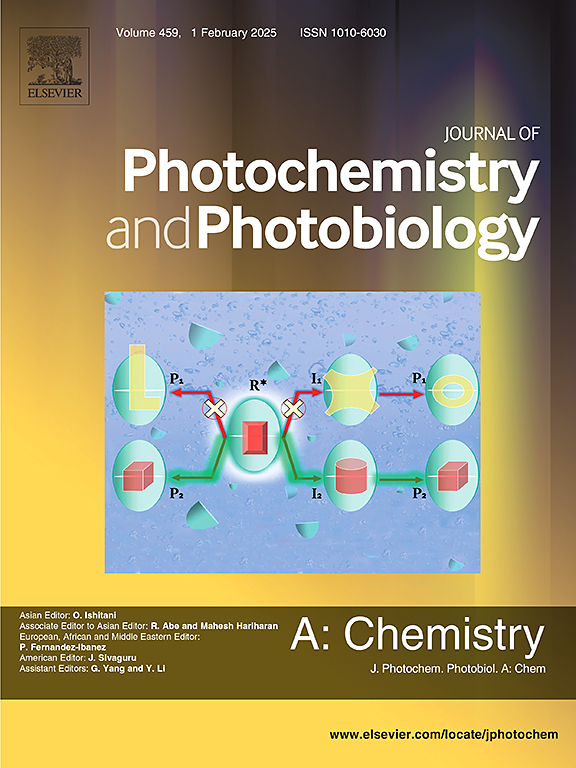新型全光谱蓝绿色发光荧光粉Na3YSi2O7: Eu2+的合成及发光性能
IF 4.1
3区 化学
Q2 CHEMISTRY, PHYSICAL
Journal of Photochemistry and Photobiology A-chemistry
Pub Date : 2025-07-11
DOI:10.1016/j.jphotochem.2025.116614
引用次数: 0
摘要
新型高效蓝绿色发光荧光粉的发现对实现全光谱白光LED具有重要意义,但由于晶体场的严格限制,仍然是一个挑战。本文采用高温固相反应合成了一种新型的蓝绿色荧光体Na3YSi2O7:Eu2+。详细研究了这些荧光粉的晶体结构、光致发光性能、低温光致发光光谱、衰减寿命和热稳定性。Eu2+离子占据了Na(2)+和Y3+的晶体位置。这些荧光粉的发射光谱在475 ~ 650 nm左右为蓝绿色,在365 nm处激发时,半峰全宽为71 nm。两种不同的Eu2+蓝绿色发射中心被PL光谱识别。Na3YSi2O7: Eu2+荧光粉中Eu2+离子在665 nm处在8k下有有趣的红色发射,在室温下消失。确定了Eu2+在Na3YSi2O7中的浓度猝灭机理。制备的Na3YSi2O7: xEu2+ (x = 0.005-0.025)样品的荧光寿命为几百纳秒,温度依赖性发光表明Na3YSi2O7: Eu2+的热稳定性较差。用这种蓝绿色Na3YSi2O7: Eu2、商用红色荧光粉和365 nm紫光芯片制备的LED可发出高质量的中白光(CRI = 89, CCT = 4049 K)。我们的研究结果表明,新型的蓝绿色发光Na3YSi2O7: Eu2+荧光粉有望在全光谱白光LED领域具有潜在的应用前景。本文章由计算机程序翻译,如有差异,请以英文原文为准。

Synthesis and luminescent properties of novel cyan-green-emitting phosphors Na3YSi2O7: Eu2+ for full-spectrum lighting
The discovery of novel high-efficiency cyan-green-emitting phosphors is great meaningful for the achievement of full-spectrum white LED, but still a challenge due to the strict crystal field limitation. Herein, we present a novel cyan-green-emitting phosphor Na3YSi2O7:Eu2+ synthesized by high-temperature solid-state reaction. The crystal structure, photoluminescence (PL) properties, PL spectra at low temperature, decay lifetime and thermal stability of these phosphors are investigated on detailed. The Eu2+ ions occupy the Na(2)+ crystallographic sites and Y3+ sites. The emission spectra of those phosphors consist of a cyan-green emission bands around 475-650 nm with a full width at half maximum (FWHM) of 71 nm upon the excitation at 365 nm. Two different Eu2+ cyan-green-emitting centers are identified by the PL spectra. The interesting red emission of Eu2+ ions in Na3YSi2O7: Eu2+ phosphor at 665 nm is observed at 8 K and disappeared at room temperature. The concentration quenching mechanism of Eu2+ in Na3YSi2O7 is determined. The fluorescence lifetimes of the as-prepared Na3YSi2O7: xEu2+ (x = 0.005–0.025) samples are several hundred nanoseconds and the temperature-dependent luminescence indicated Na3YSi2O7: Eu2+ is poor thermal-stable. High-quality neutral-white light (CRI = 89, CCT = 4049 K) were emitted from the LED fabricated by this cyan-green Na3YSi2O7: Eu2, commercial red phosphors and 365 nm violet chips. Our results indicate that novel cyan-green-emitting Na3YSi2O7: Eu2+ phosphors are expected to have potential application in the field of full-spectrum white LED.
求助全文
通过发布文献求助,成功后即可免费获取论文全文。
去求助
来源期刊
CiteScore
7.90
自引率
7.00%
发文量
580
审稿时长
48 days
期刊介绍:
JPPA publishes the results of fundamental studies on all aspects of chemical phenomena induced by interactions between light and molecules/matter of all kinds.
All systems capable of being described at the molecular or integrated multimolecular level are appropriate for the journal. This includes all molecular chemical species as well as biomolecular, supramolecular, polymer and other macromolecular systems, as well as solid state photochemistry. In addition, the journal publishes studies of semiconductor and other photoactive organic and inorganic materials, photocatalysis (organic, inorganic, supramolecular and superconductor).
The scope includes condensed and gas phase photochemistry, as well as synchrotron radiation chemistry. A broad range of processes and techniques in photochemistry are covered such as light induced energy, electron and proton transfer; nonlinear photochemical behavior; mechanistic investigation of photochemical reactions and identification of the products of photochemical reactions; quantum yield determinations and measurements of rate constants for primary and secondary photochemical processes; steady-state and time-resolved emission, ultrafast spectroscopic methods, single molecule spectroscopy, time resolved X-ray diffraction, luminescence microscopy, and scattering spectroscopy applied to photochemistry. Papers in emerging and applied areas such as luminescent sensors, electroluminescence, solar energy conversion, atmospheric photochemistry, environmental remediation, and related photocatalytic chemistry are also welcome.

 求助内容:
求助内容: 应助结果提醒方式:
应助结果提醒方式:


